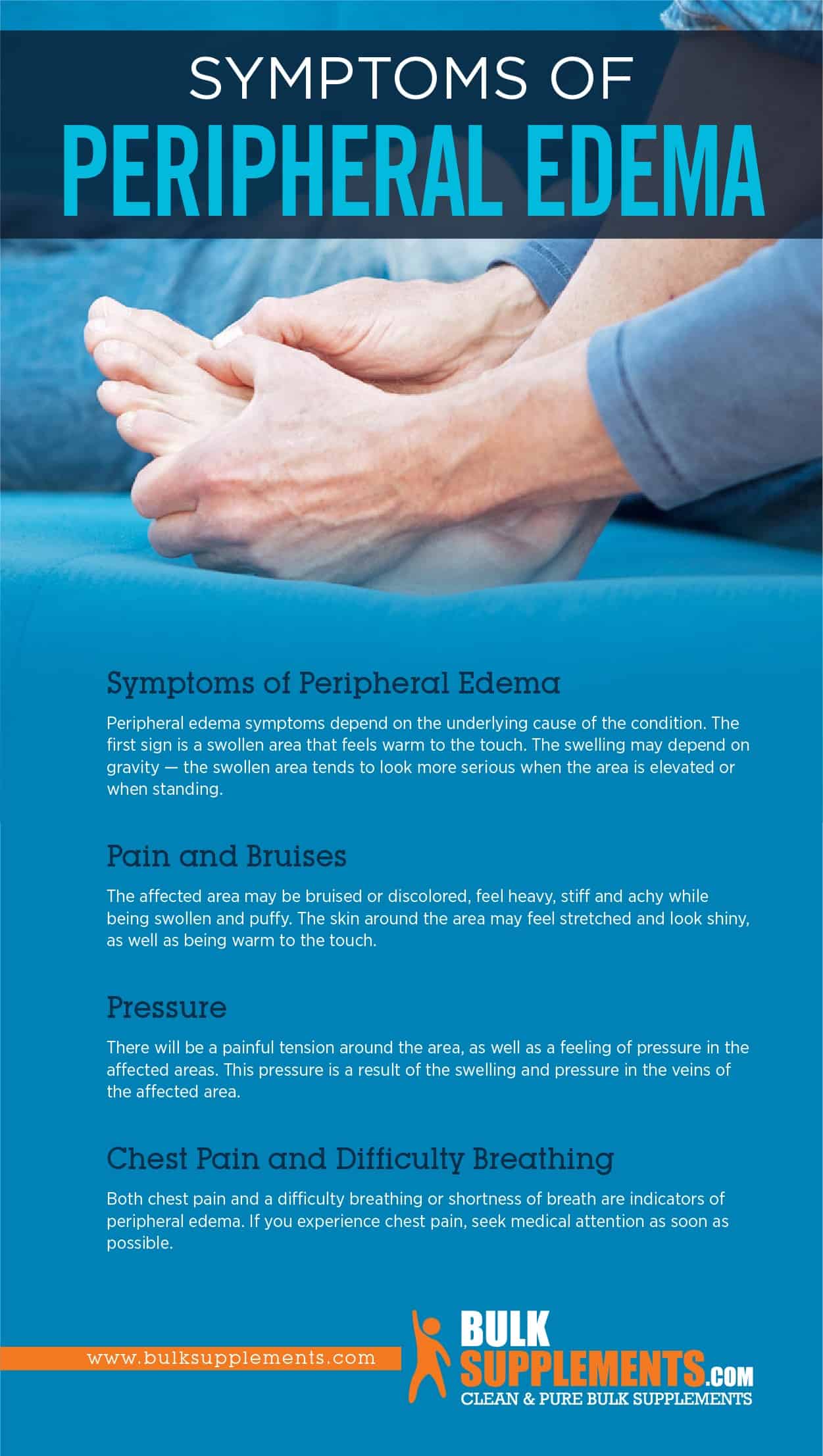Peripheral Edema: Symptoms, Causes & Treatment

Peripheral Edema
What is Peripheral Edema?
Edema, or oedema, is the medical term for swelling. Different body parts may swell due to inflammation or injury. Edema occurs when tiny blood vessels leak fluid into body tissues. This excess fluid accumulates, which makes the tissues swell. Edema can occur in almost any part of the body. Peripheral edema usually affects the hands and lower legs like the feet and ankles. It is gravity-dependent, meaning it increases or decreases with different body positions. For example, if an individual is standing, the swelling will appear in the legs. When lying on the back the swelling will appear on the sacrum.
Although peripheral edema can occur at any age, it is more common in pregnant women and older adults. Peripheral edema has numerous causes. It can subside overnight if the cause is mild. Peripheral edema caused by a more serious underlying condition is constant during the day and night. Underlying causes of peripheral edema are mostly diseases, such as cirrhosis of the liver, heart failure and kidney disease. Peripheral edema can also occur if an individual is overweight, has an infection or if there is a blood clot in the leg.
Signs and symptoms of peripheral edema vary depending on the underlying cause. The affected areas may feel heavy or stiff, appear swollen and puffy or be bruised or discolored due to an injury. Other symptoms include tight or warm skin and difficulties walking due to swollen legs.
Symptoms of Peripheral Edema
Peripheral edema symptoms depend on the underlying cause of the condition. The first sign is a swollen area that feels warm to the touch. The swelling may depend on gravity — the swollen area tends to look more serious when the area is elevated or when standing.
Pain and Bruises
The affected area may be bruised or discolored, feel heavy, stiff and achy while being swollen and puffy. The skin around the area may feel stretched and look shiny, as well as being warm to the touch.
Pressure
There will be a painful tension around the area, as well as a feeling of pressure in the affected areas. This pressure is a result of the swelling and pressure in the veins of the affected area.
Chest Pain and Difficulty Breathing
Both chest pain and a difficulty breathing or shortness of breath are indicators of peripheral edema. If you experience chest pain, seek medical attention as soon as possible.

Causes of Peripheral Edema
Peripheral edema can be caused by certain health conditions. In some cases, the cause is just a harmless case of water retention. It can also occur due to a chronic or serious condition that requires prompt treatment.
Water Retention
The water stored in the body may accumulate in tissues, which can cause temporary swelling of the feet, hands and ankles. This may happen when a person has consumed too much sodium. Water retention can also result from sitting or standing in one position for long periods. Hormonal changes during pregnancy or menstrual cycle can cause water retention in women. During pregnancy, the uterus exerts a lot of pressure on the blood vessels responsible for transporting blood back to the heart from the legs. This pressure causes fluids to get into the surrounding tissues, causing swelling in the lower legs. Severe swelling during pregnancy could indicate the development of preeclampsia, which is a serious condition characterized by high blood pressure and swelling.
Congestive Heart Failure
This medical condition makes both the lower heart chambers lose their functionality. As such, they are not able to pump blood effectively. As a result, blood may back up in the legs, feet and ankles, leading to edema. Congestive heart failure can also lead to swelling of the abdomen. People with this condition may experience difficulties breathing or shortness of breath if fluid builds up in their chest.
Certain Medications
Peripheral edema may be a side effect of certain drugs, especially those that involve regulating water or hydration. These medications can cause an imbalance between sodium and water in the body. The edema might also be influenced by the dosage and duration in which the drugs are taken. Some of these medications include antidepressants, steroids and blood pressure medicines known as calcium channel blockers. It can also be caused by estrogen hormone found in birth control pills.
Kidney Diseases
The extra fluid and sodium in people with kidney disease can lead to peripheral edema. This happens because the kidneys are not able to get rid of enough water and sodium, leading to pressure buildup in the blood vessels, especially in the legs. Kidney disease can also cause edema around the eyes.
Liver Cirrhosis
When the liver is damaged or is scarred, it can result in peripheral edema by exerting pressure on the veins that serve the legs. Cirrhosis is a late stage of liver scarring. It causes fluid to accumulate in the abdominal cavity (ascites). People who experience this condition should seek immediate medical attention.
Venous Insufficiency
This is the most common cause of peripheral edema. It affects close to 30 percent of the entire population. This is when the veins in the legs are damaged or weak and cannot pump blood back to the heart. Blood then accumulates in the lower legs. This condition can be inherited and is more common in women than in men.
Inflammation
Inflammation can be the body’s response to an injury, trauma, allergies, arthritis, cellulitis, gout or an infection. If inflammation occurs in the tissues in the lower leg, it causes swelling in the area.
Blood Clot
A blood clot can be diagnosed by a sudden onset of pain and edema in one leg. Many refer to this medical condition as deep vein thrombosis (DVT). DVT can be a result of a variety of things including prolonged sitting in cramped conditions.
Lymphedema
When the lymph system is damaged, it can cause fluid accumulation in tissues resulting in peripheral edema. Lymphedema occurs as a result of surgery that is aimed at removing cancerous lymph nodes. This is known as secondary lymphedema, and it’s common in the United States and other industrial countries.
Primary lymphedema is rare and affects the arms and legs. It can also be inherited. Thirty percent of all lymphedema cases occur in both arms or both legs. It is a painless condition and is usually not tender. The most common cause of lymphedema in developing countries is filariasis, which is a parasitic infection caused by the roundworm and affects over 90 million individuals. Lymphedema can also be caused by obesity and venous insufficiency.
Severe or Long-Term Protein Deficiency
Protein deficiency that is caused by malnutrition can also cause edema. Proteins help to hold sodium and water in the blood vessels to prevent fluid from leaking into the tissues. If albumin (blood protein) level drops too low, fluid is retained and edema occurs, especially in the lower legs, ankles and feet.
Diagnosis
For a doctor to understand the causes of peripheral edema, they will perform a physical exam by asking about the patients’ medical history. This information helps to determine the underlying cause of the condition.
Depending on the patient’s medical history, the doctor may render some tests necessary, such as:
SEE ALSO

Bronchitis: Symptoms, Causes & Treatment
- Urinalysis
- Blood tests especially of liver function
- Chest X-ray
- Evaluation of the liver and kidney function
- Abdominal ultrasound
- Ultrasound of the affected areas like the legs to examine the veins in the legs
Although edema is physically limiting, it is important to determine the underlying cause so that the type of treatment used will target the specific condition causing peripheral edema.
Treatment for Peripheral Edema
Treatment mainly focuses on the swelling. Mild peripheral edema usually goes away on its own without any treatment. In some cases of recurring peripheral edema, diuretics may be prescribed to help lower the swelling, especially in individuals with heart failure. However, they can cause side effects. According to research, chronic diuretic use can cause a deficiency in potassium and a decrease in blood volume in the blood vessels.
Diuretics might not be effective for patients with non-pitting edema because it is so difficult to treat. However, they can reduce the swelling by wearing compression stockings and elevating their legs periodically.
If the edema is mild then self treatment in the form of moving around or taking breaks from sitting or standing and exercising can help. Massaging the affected area helps push the accumulated fluid towards the direction of the heart. It also helps to lower the pressure in the blood vessels.
Lowering salt intake is also ideal. Kidneys work to regulate the amount of salt retained in the body by excreting excess sodium through urine. Certain hormones and physical factors also help in this activity. If kidneys don’t function properly, the body may retain too much salt. Adding more salt increases the risk of serious peripheral edema. The retained salt causes water retention and eventually swelling. Individuals prone to peripheral edema should lower their consumption of foods high in sodium like bacon, table salt and soy sauce.
Supplements for Peripheral Edema
Pure Parsley Extract Powder
Parsley is a natural diuretic that helps to relieve bloating and water retention. It triggers urine production by the kidneys and rids excess water that can cause peripheral edema. As a dietary supplement, take 2,500 mg (scant 1 tsp) of parsley extract powder daily, or as directed by a physician.
Dandelion Root Extract Powder
Dandelion root plays a role as a natural diuretic. It can increase the frequency of urination. Take dandelion root extract powder in servings of 1,000 mg (rounded 1/3 tsp) twice daily, or as directed by your physician.
Grapefruit Seed Extract
Grapefruit seed extract can help activate the lymphatic system and also regulate fluid retention in the body. It does this by increasing blood flow. It also promotes detoxification of toxins and waste products that can cause inflammation. Take grapefruit seed extract powder in servings of 500 to 1,000 mg up to three times daily.
Fennel Seed Extract Powder
Fennel seed can help to get rid of inflammation-causing waste products and also relieve inflammation. It possesses some anti-diuretic properties. As a dietary supplement, take fennel powder in servings of 1,000 mg (1/2 tsp) once or twice daily. The dosage may also vary depending on individuals.
The Bottom Line
Peripheral edema refers to the swelling of the arms and legs. It occurs when fluid gets retained in tissues, causing a heavy, swollen and sometimes painful area in the body. The symptoms of this condition vary according to its cause. Generally, the affected area is swollen and stretches the skin. It also feels warm to the touch. Peripheral edema can be caused by a number of health conditions and, in some cases, the cause is a harmless case of fluid retention. Edema can also come as a result of a chronic health condition that requires immediate medical attention. Such conditions include liver cirrhosis, kidney disease, venous insufficiency and congestive heart failure. Peripheral edema can be treated using diuretics and some home remedies like exercising, massage and stretching the affected areas.



